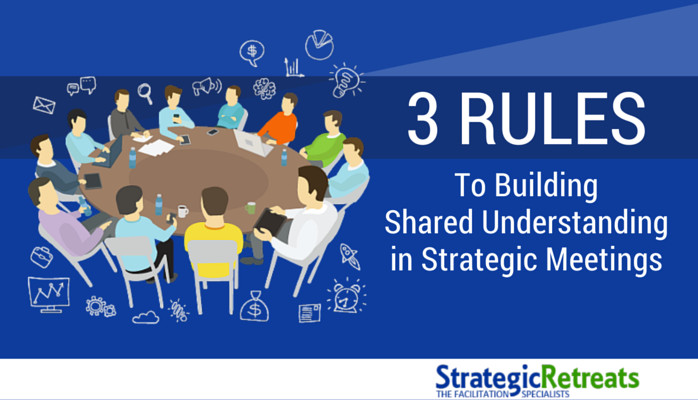
3 Rules To Building Shared Understanding in Strategic Meetings
One of the main reasons for holding a meeting – especially a strategic meeting – is to build shared understanding across all participants. Why? To ensure that after the meeting, the actions of those who were at the meeting are aligned, ensuring that what gets done moves the organization ahead in an agreed upon direction. When that shared understanding is not built, there is confusion around what people are supposed to be doing back on the job.
The rules for building shared understanding focus on getting people to spend more time listening deeply, and less time merely expressing their own well-established view of the world. Listening is hard work, so it needs considerable reinforcement to make it happen.
1. Allow only one speaker at a time
On the surface, this means only one person speaking at a time: no side conversations, and no interrupting the person who has the floor.
But the “one speaker” rule is about more than having just one person speaking at a time. The real crux of this rule is what we do while listening.
It is about ensuring that each person in the room is actively listening to the one speaker, with the intent of fully understanding what the speaker is saying and meaning, from that person’s perspective. It is not about listening to determine what to say next, either to support or rebut a point being made by the current speaker.
2. Concentrate on dialogue as distinct from discussion
Dialogue is the collective way of opening up judgments and assumptions for examination.
Dialogue comes from the Greek logos – “word” or “meaning” – and dia which translates to “through.” In essence, a dialogue is a “flow of meaning passing through the assembled group.”
Discussion, on the other hand, comes from the same root as percussion and concussion, and literally means “heaving your ideas over to the other side.”
For effective dialogue, one must suspend one’s point of view and listen to those of others with the objectives of fully understanding their perspectives and then determining how all the views expressed come together as a whole. This leads to new insight and understanding.
3. Suspend judgment until all views have been heard
In any brainstorming activity, the stated requirement is not to judge or evaluate ideas as they are put forward. This only means that you must not express the judgment that you are feeling inside, even if you think it’s about the worst idea you ever heard!
As humans, it is virtually impossible stop judging: it’s part of who we are, and we’ve had lots of practice doing it. That judgment just needs to be suspended and put to the side while the dialogue is proceeding. This encourages people to listen fully to the speaker and ensure a complete understanding of what they and the other speakers are saying and meaning.
At the same time, it’s important not to discard that judgment, since it will be useful later on in the evaluation stage. Judgment is merely deferred, not lost.
When people in the room are actively and sincerely listening to what others in the room are saying, working hard to understand from the perspective of the speaker, then relating these views to their own to make it a complete “whole,” there is a greater likelihood that those involved will develop a shared understanding and be more open to collaboration when back at their jobs.
To assess how well you're doing in your strategic meetings, take the Best Meeting Evaluator™ test here.
About the Author
Bob is a Strategic Planning Facilitator drawing on 40 years’ experience working with Canada’s leading organizations. He provide executives with a safe space to ask and answer questions, take the time to analyze and discuss strategies and challenges, and consciously build their business and their careers from the inside out. Connect with Bob on Linkedin and visit him at strategicretreats.net


